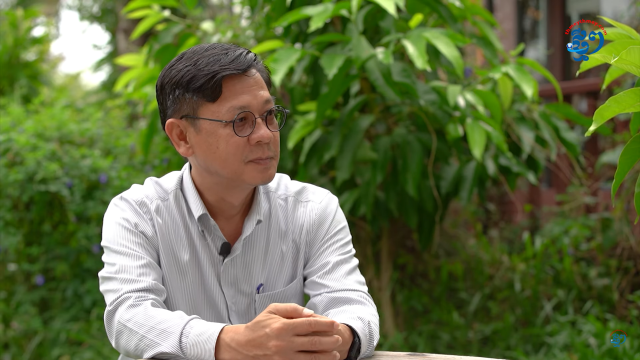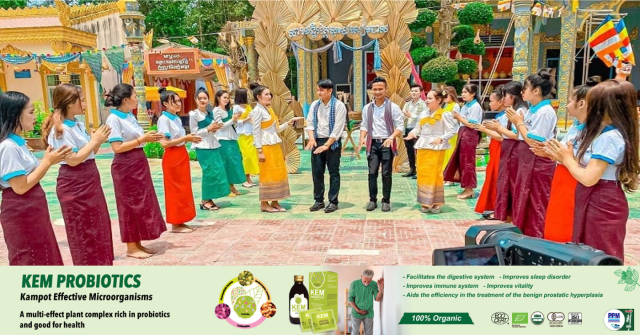Bringing Back the Original Look of Angkor

- By Ky Soklim
- December 13, 2022 3:55 PM
SIEM REAP - Travelling back in time is generally associated with science-fiction. As things have aged for thousands of years, it is not surprising to see people imagining what old times were like.
Despite the passage of time, through studies and educated guesses it is possible to transform an aging monument into a resemblance of its younger self.
For 30 years inside the UNESCO’s World Heritage list, the Angkor Archaeological Park has seen a noticeable change in its environment, recognition and the plan for its future.
Sitting at a front yard of a newly built cafe hidden inside the Angkor Botanical Garden, Hang Peou, general director of the APSARA National Authority, tells why this institution wants to restore the Angkor environment to what it might have looked like.
Ky Soklim: First of all, I want to focus on the achievements of the last 30 years, namely after the Angkor Archeological Park was registered as UNESCO’s tangible heritage. To you, are there any achievements in which you want to express to the public as well as the International Coordinating Committee of Angkor since the meeting will take place in December?
Hang Peou: This is a big question and I will explain it through stages. At the beginning, Angkor Wat was facing danger. For the first 10 years, we solely focused on preservation work. We had to make sure that the temple does not fall down due to mines and other explosives. It is also a stage which expresses the pride of our government who has allowed the Angkor Wat temple to be registered as a heritage just like any other temple. In that year, 1992, Angkor Wat was registered as an at-risk monument. Ten years later, we have saved it from danger. Next, we have jumped into the stage of preservation and development. In this stage, we were trying to think of a new angle, an angle of how we can develop this region, with hundreds of temples and other ancient traces, sustainably. When we think about this, we start looking into the people, the water, the forest and so on. At the same time, we also do not forget about the urban area of Siem Reap, a provincial city. As the country is getting more stable, more places are also registered as heritage sites. Therefore, an increasing number of tourists come to visit the country and we have to be able to accommodate them. We have to make sure that the tourists also get to know something else besides just visiting the temples alone. We also want the tourists and the local people themselves to know, in detail, the heritage of our country. So, in general, we should think of the temples, the environment and the people. After knowing that the temples are stable enough, we begin to focus on the tourists’ experience such as the construction of an area in front of the Angkor Wat temple to show the might of the Angkor Empire during the earlier times. We also improve this kind of experience at other locations such as the interior of the temples and the villages. For the last 30 years, the face of Angkor has dramatically changed. We have to match the experiences between the people and the temples. This means the people will not destroy the temples and the temples will not disturb the people.
_1670922376.png)
Ky Soklim: For the last 10 years, I feel like authority has wanted the present day Angkor Park to resemble itself a millennia ago. Is that what the institution is trying to aim for?
Hang Peou: This is the principle idea which we have incorporated into our master plan. Of course, this is not something new. Let me offer you a very obvious example. In front of the Angkor Wat temple, a proper axis must exist. There must be a finding that the temple is not the only thing here. There must also be areas in front and on the sides of the temple. When we look at the plan of the ancient temples, there were proper rules and guidelines. The ancient people were thinking long term. However, some later developments were conducted with a bit of a confusion. Some ancient roads were cut into two or even three pieces. For example, the road leading to the Takeo temple was a highly zig-zagging path which also disturb the bank of the temple’s moat. After our studies, we found out that the ancient route did not take this shape. So, we have altered the zig-zagged route back to the ancient trace. We can achieve these things thanks to the advancement of new technologies such as LiDAR (Light Detection and Ranging) and the more experienced experts. At the front of the Terrace of the Elephants, upon researching the old document, we were able to trace back the ancient route and so we rebuilt it. It seems to be a new route, but it is actually an old one.
_1670922301.png)
Ky Soklim: At this present time, the area in front of the Angkor Wat temple has been renovated with a beautiful garden and trees. This is also because APSARA wants this space to resemble that of the past. However, which era does this thing seem to resemble?
Hang Peou: There are three elements which are always present in our culture and these are temples, water and forest. These things have to be integrated together. We have talked plenty about the water, but we have not focused sufficiently on the advantage of forest. More than just beauty, they also reduce the strength of wind. Our temple stones do not have anything to lock one another strongly together. Furthermore, during hot days, the trees produce moisture which reduces the temperature on the stone and keeps the stone from cracking. We cannot say which era or years that we are heading back to. It is a matter of further studies. But we can know the ancestors’ concept that in front of the temples, there should not be any messy environment or any other improper axis. If we can understand our ancestors' concept, we can easily renovate and restore the places back.
_1670922562.png)
Ky Soklim: Why does APSARA and the government want Angkor Park to resemble the past?
Hang Peou: We want to preserve the universal value. When we tried to enlist Angkor Park as a world heritage site, we described what the value of Angkor must stand upon. We have to respect the OUV, or Outstanding Universal Value. Every heritage has to preserve this statement. If the originality of the heritage can be reached, it indicates the strength of the leadership and the country that manages the heritage. At the same time, this is also a magnet which attracts tourists. People want to see ancient stuff which resembles that from the past. No one wants to see a replica or improvised stuff. If we can return back to the originality of an object, that is what people want to come to see and learn. Although we cannot make it completely old, at least we can retain the main universal concepts. This is the duty and the mission in which we have to do.
Ky Chamna contributed to this story.















